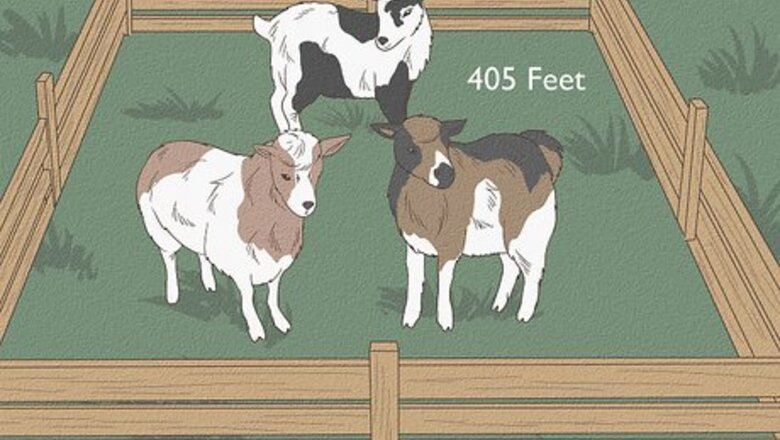
views
Preparing Your Yard and Barn

Set aside at least a 10 by 13 ft (3.0 by 4.0 m) romping space for each goat. Even mini goats need a decent amount of space. You'll need about 135 square feet (12.5 m) of space per goat that you have in your herd. Nigerian dwarf goats are very playful, and they love to romp and climb on things. So if you have 3 goats, for example, you'll need about 405 square feet (37.6 m) of space. Keep in mind that you'll need to have separate areas for males and females.
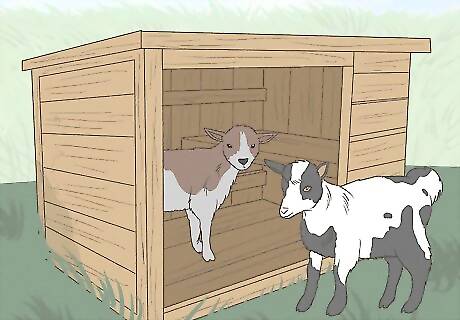
Provide 20 square feet (1.9 m) of shelter space for every 2 goats. While Nigerian dwarf goats do need a lot of romping space, they don't need as much housing space as other goats due to their diminutive size. A shelter that is 4 by 5 feet (1.2 by 1.5 m) is enough for 2 goats. The height needs to be tall enough for you to be able to clean it out, as these goats rarely get above 2 feet (0.61 m). Of course, you need to scale up if you add more goats to your herd. Add 10 square feet (0.93 m) for each goat. This enclosure should be well-ventilated and dry. Most of the time, you can house does together as long as one of them isn't particularly aggressive. Bucks will need to be housed on their own. You can build your own shelter or purchase one online. Basically, it just has to be a sturdy shed.
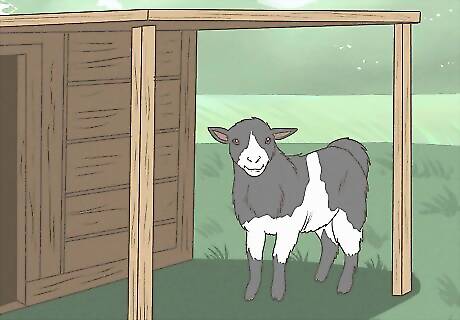
Give them shade and sun. Your goats need a little of both to be happy. You can use a shelter or trees to provide the shade. Keep in mind, though, that goats can be destructive, so umbrellas or tents are likely to get destroyed. You should have enough shaded space that all of your goats can relax in the shade.

Use solid, strong fencing to keep your goats inside. Solid wood fencing is a good choice, as long as it's reinforced with sunken wood posts. Your goats will run their sides along the fence when winter is over to get their shedding fur off, and they'll do it over and over again, which is why your fence needs to be sturdy. They'll also enjoy chewing on the fence. Your fencing should be at least 4 feet (1.2 m) high for Nigerian dwarf goats. Keep in mind that Nigerian dwarf goats are small. If they can push their head through somewhere, they can escape your fence. Also, solid fencing provides protection from the wind.

Place the enclosure at the back end of your property to reduce noise. Nigerian dwarf goats can be very loud, and the noise can get a bit annoying if you're not used to it. Placing the enclosure away from your home will help reduce this noise. Does in heat are particularly loud.
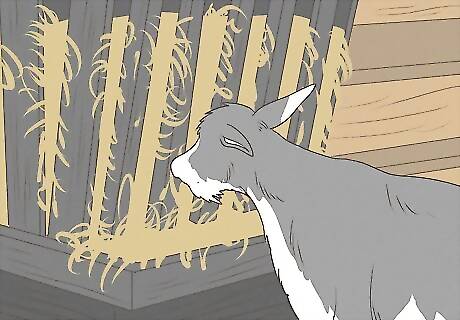
Place feed in a manger that keeps food off the ground. Goats are relatively picky about their food. They won't eat it if it falls on the ground and they step on it. They also won't eat it if they use the bathroom too close to it. Therefore, you have to keep it off the ground using a manger. Purchase a manger that is an appropriate size for your smaller goats; they only get about 20 inches (51 cm) tall. They can't eat the food if they can't reach it. Therefore, the part of the manger where food comes out should be under 2 feet (0.61 m) but off the ground. A good option is a manger with bars close enough together to keep the hay in and the goats' heads out. The bars are angled at a "V," and you place the hay inside, where they can pull it out through the cracks. Typically, the bars are spaced 4 inches (10 cm) apart.
Building a Herd

Acquire goats in pairs at least. Goats enjoy being in a herd, so they typically won't be happy by themselves. That means that you should get at least 2 goats to start out with so that you won't have one lonely goat. You can keep 2 females together, but you shouldn't try to keep a male and a female together or 2 males together. Nigerian dwarf goats can cost anywhere from $50-$500 USD, depending on what your needs are. You'll pay higher prices for pedigree goats that you want to breed and sell, or ones that are particularly good for milking. However, if you're new to raising goats, don't overwhelm yourself. Stick to 2 goats to start with, and build your herd up later on.
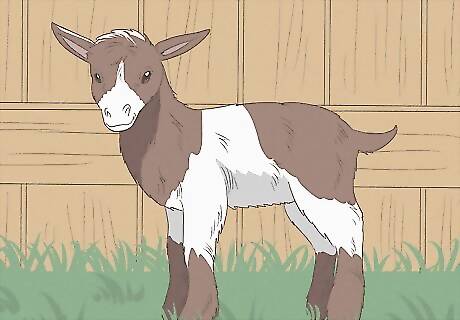
Wait until your does are 1 year old to breed. While does can be bred as early as 7 months, it's best to wait until they're at least a year old. Your doe will be full grown then and able to better carry and care for any kids she bears. Goats have a gestation period of about 5 months. Your goat can have 3-5 kids at once.
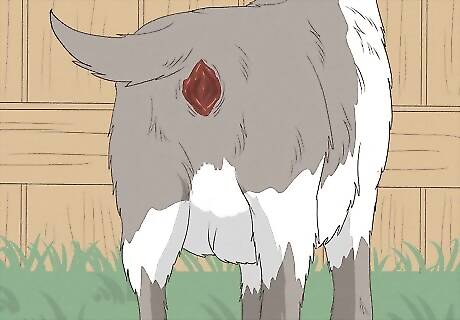
Watch for signs your doe has gone into heat. When a doe goes into heat, she's ready to breed. Typically, does go into heat every 21 to 28 days all year round. This period lasts 1-3 days each time. A doe will make a lot of noise while in heat. She'll also pace, wag her tail, and try to get to any nearby bucks. You may notice her vaginal area is dirty from discharge. You may also notice she urinates more often and is not as hungry as she normally is.
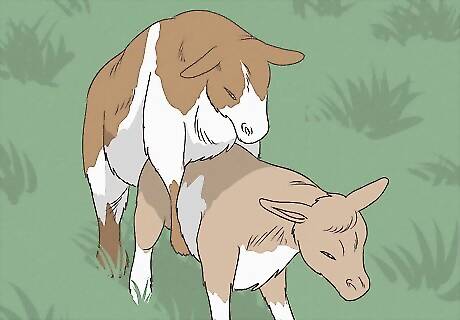
Breed your goats for milk and kids. To get milk from your does, you need to breed them. That can be as easy as having a male around when a female goes in heat. Nigerian dwarf goats can breed any time during the year, but you do want to stagger your goats' breeding sessions to ensure you have a steady supply of milk. You shouldn't breed a single goat more than 3 times in 2 years. You need to keep males and females apart until you are ready for them to breed. If you just have does, it's a good idea to pay someone to bring a buck in to impregnate them. That way, you can get a quality buck without having to pay a lot of money to own one. The best quality bucks will be registered, such as those registered with the American Dairy Goat Association. Ask around for the going rate in your area. The best way to choose a buck is to pick one that will improve weaknesses in your herd. For instance, maybe you have goats with low milk production, so you want a buck that helps increase production in the next generation. The owner will be able to tell you what qualities the buck can assist with.

Watch for pregnancy. It's difficult to spot pregnancy on a goat from physical signs. You may notice a larger abdomen on the right side, or the doe might get swollen ankles and become cranky. However, every doe will exhibit different symptoms. The most accurate way to check for pregnancy is to use a scientific method like a blood test, milk test, ultrasound, or x-ray. Your veterinarian can perform the blood or milk test, or you can send a sample off to a lab. You can also use an at-home kit to test your does, available online. Ultrasounds and x-rays are the most accurate, but they tend to be more expensive. They generally require a trip to the vet, though some vets have portable ultrasound machines.

Help your doe give birth. Watch for signs your doe is getting ready to give birth soon. She'll develop a more pronounced udder that feels almost hard to the touch. Some will get mucus dripping from their back end, and others will walk around and call out, like they're trying to find something. When they start giving birth, they'll call out, and you'll hear straining and pushing sounds. To help, put on gloves, and lay out fresh straw. If she seems to be struggling with not much happening, place a little KY Jelly on your finger and gently massage the inside of her vulva. If she hasn't given birth after an hour, stick your hand inside her vulva and gently press the baby back, which can help turn it. The baby should be born head first with 2 hooves, though it doesn't always happen this way. Keep in mind she may give birth to 3-5 babies. If the umbilical cord for each kid doesn't break by itself, shred it with your fingernail; don't cut it.
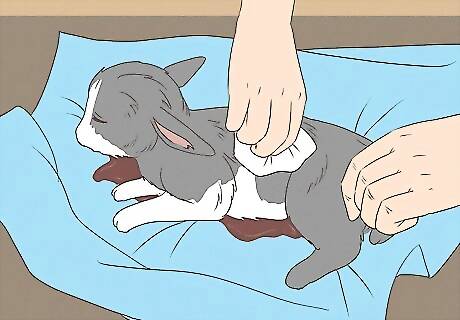
Care for the new baby kid. Dip each kid's umbilical cord stub and belly button into a cup of iodine, and turn the kid over so it runs down the area. Use a fresh cup for each kid. Wash the kid in warm water directly after labor. Dry it as thoroughly as you possibly can. Other than that, leave the kids alone to drink from their mom. If a kid is screaming, you can help it find the milk. Check to make sure the doe's teats are giving milk by pulling milk from each one. If one isn't, gently scrape your fingernail over the end to remove the plug.
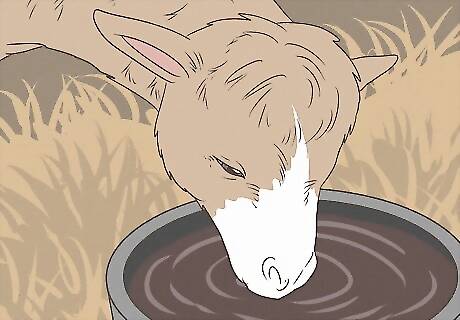
Care for the doe after birth. If you must insert a finger in the doe, make sure to give her a shot of antibiotics once she's done giving birth. Also, try providing a bucket of warm water with 0.5 c (120 mL) of molasses, which gives her energy and water. You can also give her grain. Give her an extra half serving of grain for the next 4 days or so. Also, watch for the afterbirth. It can take anywhere from an hour to 12 hours to appear. She may eat it for the nutrients.
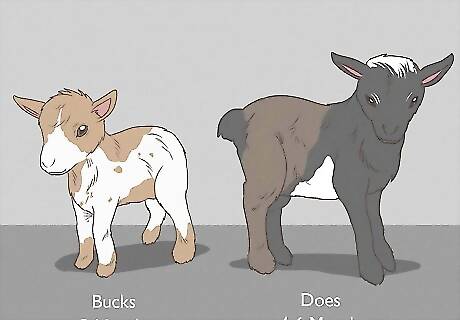
Wean bucks at 3 months and does at 4-6 months. Bucks need to be separated from their mothers earlier because they can impregnate their mothers if left too long. Does can be left a bit longer with their mothers. The young goats will already be grazing and/or eating other food by this time. You simply have to move them as far as you can from their mothers to their own pen, so they can't hear their mothers calling and vice versa. Separate them earlier in the day so they have a chance to get used to the new area. Feed them as you would your other goats with some extra grain in their food.
Feeding Your Goats
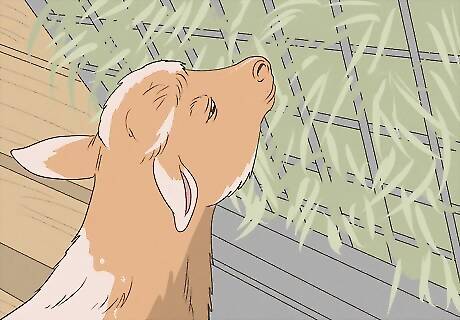
Provide 3 to 5 pounds (1.4 to 2.3 kg) of hay per day for each goat. Nigerian dwarf goats do well on an equal mix of leguminous hay and grass hay. Grass hay includes timothy and orchard grass and is lower in protein. Leguminous hay includes alfalfa and clover and is higher in protein. For young kids or lactating does, you can feed leguminous hay only.
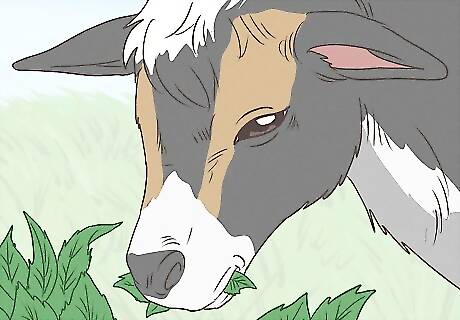
Allow foraging or bring in foraged plants. Foraging is also good for goats, and they prefer to forage in woody areas. While it's not necessary for a healthy goat, allowing foraging can cut back on your food bills. Some vegetation is toxic to goats, including mountain and laurel ferns, azaleas, and rhododendrons. Typically, your goats will avoid toxic plants as long as they have plenty of other food. However, plants like poison ivy, chicory, dandelion, thistle, and nettle are fine for goats.
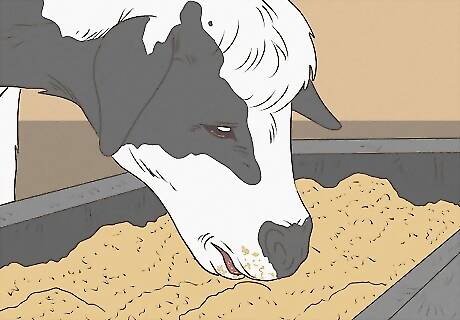
Add in some pre-mixed grain made for Nigerian dwarf goats. You need a grain mix meant particularly for goats because they have nutritional needs that other livestock do not. For instance, they need copper in their feed while sheep do not. You can find grain mixes at your local livestock feed store. You can feed hay freely, but you should calculate the amount of grain you need for each goat per day. Lactating does and kids particularly benefit from having grain in their diet. The amount you give is typically listed on the back of the package. For instance, you might feed 1 pound (0.45 kg) of grain mix for each 3 pounds (1.4 kg) of milk a doe gives, while you might feed 1%-3% of a kid's weight to them in grain.
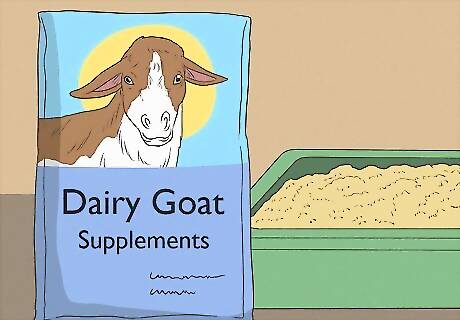
Use supplements to provide your goats with nutrients. You can find supplements made particularly for goats. For dairy goats, make sure the supplement is 16% calcium and 8% phosphorus, or at the very least, that it contains a 2:1 ratio of calcium to phosphorus. You can free feed this supplement. You can also give your goats baking soda mixed in with the supplement or as another free-feed option.
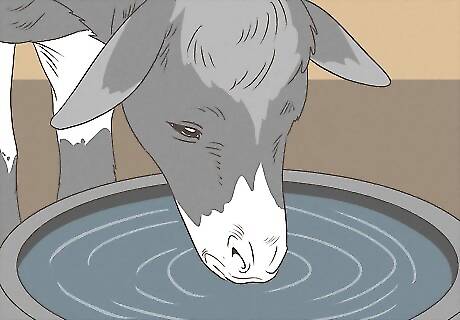
Give your goats plenty of fresh, clean water. Goats are particular about their water and want it kept clean, so change it daily at least. Some goats like warm water, so try that out to see if you can encourage them to drink more; they especially like warm water in the winter. If you're using your goats for milk, water is especially important.
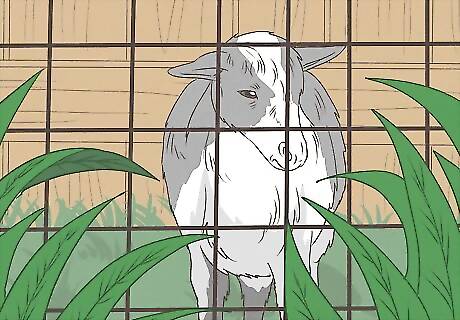
Keep your dwarf goats away from any plants you don't want eaten. Nigerian dwarf goats will eat almost any vegetation in your yard, from weeds and grass to flowers and bushes. If you don't want them to eat something, keep them out of that part of the yard.
Providing Care

Shovel their manure once a day. When manure sits around, it can attract flies and small animals to the enclosure, which can bring in diseases. Removing manure at least once a day helps keep these pests at bay. You can use the manure in your garden by mixing it in with the soil.
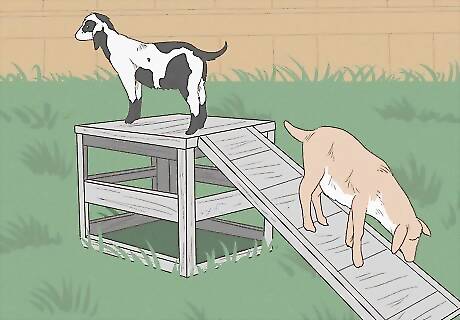
Include toys for entertainment and enrichment. Your goats will get just as bored as a dog or cat if they don't have toys. However, toys for goats are quite a bit different. Try stumps, rocks, and anything else they can climb on. You can even use things like old cars or furniture. Keep in mind that they may chew on anything you leave in the area, though they tend to go for more natural items, like wicker or wood. While goats will chew on a variety of things, they typically won't eat throw non-food items if you're feeding them properly. For instance, they usually won't eat things like tires or hoses.

Trim your goats' hooves every month and a half. If you're not confident doing this yourself, you can pay someone to trim the goats' hooves. Otherwise, it's best to have a breeder or your vet show you how to do it, as they can demonstrate how far to cut and the correct way to hold your goat. You'll need well-maintained hoof trimmers and gloves to trim hooves.

Find a veterinarian who specializes in farm animals. Even if you are keeping dwarf goats in the city, they're still considered farm animals. Vets who treat farm animals are likely to be in the outskirts, closer to farms and ranches, so you'll need to look around to find one for treating your goats. Ask for a recommendation from your local vet or from friends who have goats. You could also check online reviews to gauge quality. Goats can suffer from conditions like pneumonia, lice, worms, and udder infections.
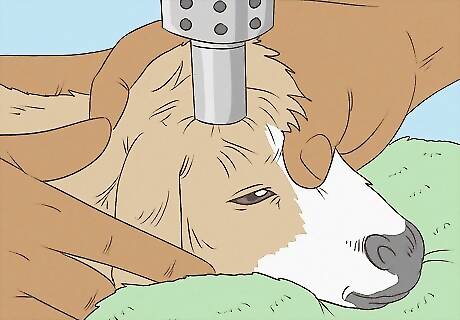
Have their horns removed a few days after birth. Typically, you should have your goats' horns removed to protect them from themselves. They can injure other goats in your herd with their horns. Plus, they can injure you with them if you leave them on. If you wait longer than a few days after birth, it's more traumatizing to the goat. Your vet can remove the horns.
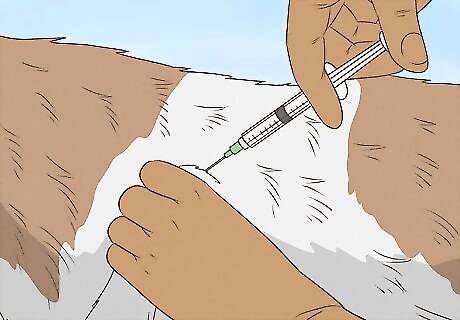
Give preventative care to your goats. You should have your vet give vaccinations once a year, and they can advise you on which vaccinations you'll need. Additionally, you should worm your goats 3-4 times a year. Talk to your vet about setting up a schedule for vaccinations and worming.


















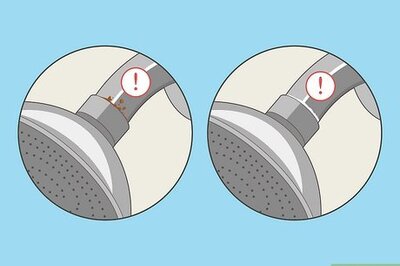
Comments
0 comment